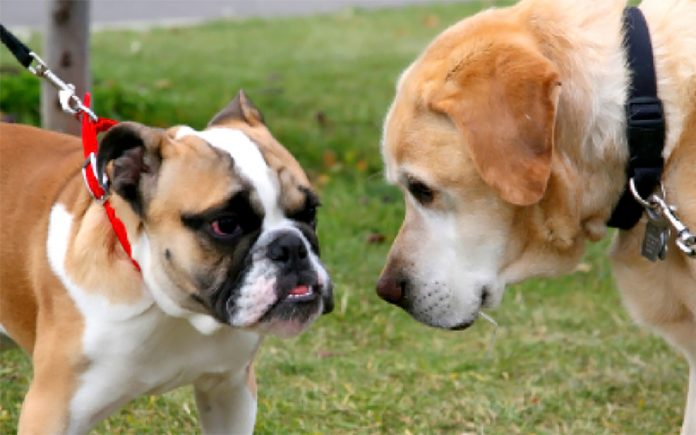
By Janet McAfee
Thousands of folks, isolated during the quarantine period, adopted dogs from animal shelters. These dogs eased the stress and loneliness of staying at home. Now as people return to work or school, adopting a second pup may be just the right anecdote to help Fido when he is suddenly left alone all day.
Ideally, you want to bring your resident dog to the shelter to meet a prospective match before adopting. However, during the pandemic you need to check with each shelter on their meeting policy.
Sadly, many dogs are returned to shelters and rescues because of problems between them and the resident dog(s). This might include fighting or disinterest in each other. You may be disappointed there isn’t an immediate happy bond. Local dog trainer Jim Turcott advises you give dogs 3 to 4 weeks to adjust. One older dog sulked in a corner for a week when a younger pup arrived……but several weeks later the two happily ran through the house in endless joyful games as the youngster miraculously gave the oldster a “new lease on life”.
Two dogs doubles the fun and the love in your household. Dogs are pack animals, and almost always thrive on each other’s company. But just like humans, not all dogs like each other. In a few cases, two dogs may never be compatible house mates. Sometimes it’s just a matter of time in getting to know one another. Here are some things to think about and some techniques to help things go well with the transition.
INTRODUCTION TECHNIQUES
Prior to meeting: Dog trainer Jim Turcott has some excellent advice to help ensure a good result, “Before they meet, put some of the new dog’s saliva on your hand, and present it to your own dog to smell. A dog’s strong sense of smell allows them to detect the other dog’s mood from the saliva, and helps them relax when they finally interact.” Remain calm, in control, and optimistic. The animals will sense your mood and respond to it.
Choose a neutral location: Introduce the dogs in a fenced neutral location, such as a park or neighbor’s yard, keeping them both on a leash. This makes it less likely that your resident dog will view the newcomer as a territorial intruder. A separate person should handle each dog.
Use positive reinforcement: Let the dogs experience good things when they first meet. Use a happy tone of voice when you speak to them. It’s normal for them to sniff each other, however don’t allow them to investigate and sniff each other for a long time which could culminate in an aggressive response. Have them “sit” and reward them both with a treat. Each person walks with their dog walking parallel, continuing with periodic food rewards. Keep the leashes loose. Don’t use punishment.
Pay attention to body postures: A “play bow” body posture is a sign that things are going well. When he assumes this position with front legs on the ground and hind quarters in the air, this is your dog’s invitation for playtime which usually brings a friendly response. Jim cautions adopters to exercise caution as things can happen fast, “Watch for aggressive responses that include hair standing up on the back, ears back, teeth-baring, deep growls, lengthy staring, and whale eyes where the whites of the eye show. If one of these negative behaviors starts, interrupt by calmly redirecting and putting more distance between them. Start giving them treats as they calm down, gradually bringing them closer for a treat party!”
Taking the dogs home: Once things seem to be going well, and any fearful or aggressive behaviors have subsided, it’s time to happily head home. If you have more than one resident dog, it’s advised you introduce them one at a time. Two or more could gang up on the new dog. Let the new dog explore the house first.
Feed the dogs separately: It’s wise to put some distance between their food bowls. This prevents the friction from anyone stealing food until you get to know their proclivities.
Separate them when you go out: Even if they seem like they’re getting along well, put them in separate rooms the first few times when you go out. Don’t leave bones and toys around that they might compete for.
 Introducing puppies to adult dogs: Puppies can pester adult dogs without mercy, and they may not recognize their signals that they’ve had enough. Adult dogs with good temperaments may set limits with a growl. However, adult dogs that aren’t well socialized may set limits with aggressive behavior such as biting, therefore a puppy should not be left alone with an adult dog until you’re confident there is no danger. Jim adds, “Sometimes an adult dog with a young puppy acts like a surrogate parent and takes over training and caring for the newcomer. The puppy follows it through the doggie door and learns potty training.”
Introducing puppies to adult dogs: Puppies can pester adult dogs without mercy, and they may not recognize their signals that they’ve had enough. Adult dogs with good temperaments may set limits with a growl. However, adult dogs that aren’t well socialized may set limits with aggressive behavior such as biting, therefore a puppy should not be left alone with an adult dog until you’re confident there is no danger. Jim adds, “Sometimes an adult dog with a young puppy acts like a surrogate parent and takes over training and caring for the newcomer. The puppy follows it through the doggie door and learns potty training.”
WHEN TO GET HELP
Consult with a professional dog trainer for assistance if things don’t go well. When you adopt from a private animal rescue, they may assist with training tips. Remember, a dog can be seriously injured if a fight breaks out. Negative behavior becomes ingrained with time, so act quickly when issues arise. Charts of dogs’ body postures are available online. The video, “How to Introduce Dogs the Right Way” is available on www.petmd.com. You can contact Coachella Valley dog trainer Jim Turcott at (206) 380-7776.
Be optimistic! Give the dogs time to adjust. Acknowledge the positive interactions between your dogs and enjoy watching their lifelong friendship bloom!
—————————————–
Below is a partial list of shelters and rescues in the Inland Empire with animals for adoption. You can view most of their animals online in advance of calling. If you cannot adopt, consider making a donation to one of the private rescues that rely on those funds.
COACHELLA VALLEY ANIMAL CAMPUS – This county shelter is closed but you can call for an appointment to adopt. You can view the animals at all 4 Riverside county shelters at www.rcdas.org, and get the ID number of the animal you want to meet. Email them with the animal’s ID number at shelterinfo@rivco.org and call (760) 343-3644. Located at 72050 Pet Land Place, Thousand Palms. (Public)
PALM SPRINGS ANIMAL SHELTER – The shelter is closed but you can call for an appointment to adopt. They schedule appointments Wednesday through Monday, closed on Tuesday. View their animals online at www.psanimalsshelter.org, 4575 E. Mesquite Ave, Palm Springs, (760) 416-5718. (Public)
ANIMAL SAMARITANS – The shelter is closed but you can call for an appointment to adopt. View their animals at www.animalsamaritans.org. Email acorrow@animalsamaritans.org to foster. Located at 72307 Ramon Rd, Thousand Palms, (760) 601-3918. (Private)
CALIFORNIA PAWS RESCUE – The shelter is closed but you can call for an appointment to adopt. Located at 73650 Dinah Shore, Palm Desert. View their animals at www.californiapawsrescue.com, (760) 656-8833. (Private)
HUMANE SOCIETY OF THE COACHELLA VALLEY – The shelter is closed but you can call for an appointment to adopt a dog or cat. View their animals at www.orphanpet.com. Located at 17825 N. Indian Canyon, Palm Springs, (760) 329-0203. (Private)
KITTYLAND – The shelter is closed so call for an appointment to adopt a cat. Located at 67600 18th Avenue, Desert Hot Springs, www.kittylandrescue.org, (760) 251-2700. (Private)
FOREVER MEOW – Foster based rescue for cats located in Rancho Mirage. Contact them through website www.ForeverMeow.org, or call (760) 335-6767. (Private)
LOVING ALL ANIMALS – The shelter is closed but you can call for an appointment to adopt. Located at 83496 Avenue 51, Coachella, www.lovingallanimals.org, (760) 834-7000. (Private)
MORONGO BASIN HUMANE SOCIETY – Located at 4646 Sun View Rd, Joshua Tree, www.mbhumanesociety.com, call between 11am-4pm for updates (760) 366-3786 (Private)
CITY OF SAN BERNARDINO ANIMAL SHELTER – Shelter is closed but you can call for an appointment to adopt. Hours for adoption 10am – 4pm Tuesday thru Sat. Google “City of San Bernardino Animal Shelter” for website to view animals and get the ID number of the animal you want to meet. Located at 333 Chandler Place, San Bernardino, (909) 384-1304 or (909) 384-7272. (Public)
SAN BERNARDINO COUNTY ANIMAL SHELTER AT DEVORE – Shelter closed but you can call for an appointment to adopt. Call (909) 386-9280 daily between 9am & 5pm. View animals at www.sbcounty.gov/acc and get the ID number of animal you want to meet. Located at 19777 Shelter Way, San Bernardino (Public).
DREAM TEAM ANGELS RESCUE – Foster based rescue located in Grand Terrace/San Bernardino area. Contact them through website www.DreamTeamangelsrescue.com, (360) 688-8884. (Private)












































